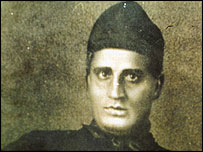Radhanath Sikdar facts for kids
Quick facts for kids
Radhanath Sikdar
|
|
|---|---|

Radhanath Sikdar
|
|
| Born | 5 October 1813 |
| Died | 17 May 1870 (aged 56) |
| Nationality | Indian |
| Alma mater | Presidency College (BA) |
| Parents |
|
| Relatives | Srinath Sikdar (brother) |
Radhanath Sikdar (born October 5, 1813 – died May 17, 1870) was a brilliant Indian mathematician. He is famous for being the first person to calculate the height of Mount Everest in 1852. His work helped us know the exact height of the world's tallest mountain.
Contents
The Great Trigonometric Survey
In 1831, George Everest was the Surveyor General of India. He was looking for a mathematician who knew a lot about spherical trigonometry. This person would join the important Great Trigonometric Survey. In 1832, under Everest's leadership, a big survey project was finished. It mapped a long line from Seronj in Madhya Pradesh to Calcutta in West Bengal.
While mapping Calcutta, Everest searched for a skilled mathematician. John Tytler, a math professor at Hindu College, suggested his 19-year-old student, Radhanath Sikdar. Today, Hindu College is known as Presidency College.
Radhanath had been a student at the college since 1824. He was one of the first two Indians to study Isaac Newton's famous book, Principia. By 1832, he had also studied Euclid's Elements and other advanced math topics. He even created a new way to draw a common line between two circles when he was a teenager. Because of his amazing math skills, Radhanath got a job with the Great Trigonometric Survey. He started on December 19, 1831, as a "computer." This meant he did complex calculations.
Sikdar's Role and Skills
Radhanath was sent to Sironj, near Dehradun. Seven other Bengali "computers" worked with him. But Radhanath quickly showed he was the best at math. He became George Everest's favorite colleague. Everest even stopped Radhanath from moving to another department once. Radhanath's job was to do geodetic surveys. This means studying the Earth's shape, how it's positioned in space, and its gravity. He didn't just use old methods; he invented new ones to measure these things very accurately.
George Everest retired in 1843. Colonel Andrew Scott Waugh took over his position. Eight years later, in 1851, Radhanath was promoted to Chief Computer. He moved to Calcutta. There, he also supervised the Meteorological Department, which studies weather.
Measuring Mount Everest
Colonel Waugh asked Radhanath to start measuring the height of mountains. Radhanath was a brilliant mathematician, even though he had probably never seen Mount Everest. In 1852, he discovered that Kangchenjunga, which people thought was the tallest mountain, was not. He collected data about Mount Everest from six different observations. Finally, he concluded that Mount Everest was the tallest mountain in the world.
When Radhanath calculated the height of Peak XV (Mount Everest), he found it was exactly 29,000 feet (8839 meters). But Colonel Waugh added two extra feet to this number. He was worried that people might think 29,000 was just a rounded guess, not an exact measurement. Waugh officially announced this height in March 1856. This height for Mount Everest was used until 1955. Then, an Indian survey recalculated it to be 29,029 feet (8848 meters).
Today, we have better technology and more data from climbers. This helps us get even more accurate measurements of Mount Everest's height. The mountain actually grows about 4 millimeters taller each year. Its summit also slowly moves northeast over time.
Other Contributions
Even though Everest and Waugh praised Radhanath's math skills, he sometimes had disagreements with the British administration. Two examples of this are known.
In 1851, a book called the Survey Manual was published. The introduction of this book said that Radhanath Sikdar wrote the more technical math parts. This manual was very helpful for surveyors. However, a later edition of the book, published in 1875 after Sikdar had died, removed that introduction. This meant Sikdar's important work was no longer recognized. Some British surveyors were upset by this. A newspaper called Friend of India even called it "robbery of the dead."
It is also known that in 1843, Sikdar was fined 200 rupees. This happened because he strongly protested against the unfair treatment of survey workers by a local official named Vansittart. A newspaper called The Bengal Spectator reported this event in detail.
In 1854, Sikdar and his friend Peary Chand Mitra started a Bengali magazine called Masik Patrika. They created it to help educate and empower women. Radhanath wrote in a simple, clear style, which was unusual for that time.
Sikdar retired from his service in 1862. Later, he became a math teacher at the General Assembly's Institution. This school is now known as Scottish Church College.
Later Life and Death
Radhanath Sikdar died on May 17, 1870. He passed away at his home in Gondalpara, Chandannagar, which was by the side of the Ganges River. He was buried at the Sacred Heart Cemetery in Chandannagar.
Recognition and Legacy
In 1864, the Bavaria branch of Natural Science, part of the German Philosophical Society, recognized Sikdar's amazing math talent. They made him a Corresponding Member, which was a great honor. This happened two years after he retired.
The Department of Posts, Government of India, released a special postal stamp on June 27, 2004. This stamp celebrated the start of the Great Trigonometric Survey in Chennai, India, on April 10, 1802. The stamps feature Radhanath Sikdar and Nain Singh, honoring their important contributions to society.
See also
 In Spanish: Radhanath Sikdar para niños
In Spanish: Radhanath Sikdar para niños

